Lag-screw fixation
1. General considerations
Introduction
Short oblique fractures (unicondylar) can be fixed with a lag screw or headless compression screw. It will have to be placed through the nonarticular face of the condyle. The lateral aspect of the phalangeal head, which is safe for screw placement, can be approached by flexing the DIP joint.
For long oblique fractures, fixation with two lag screws is recommended. All screws can be placed safely proximal to the collateral ligament of the DIP joint.

Since fragments in this segment are generally smaller than in the proximal phalanx, management and stabilization can be more of a challenge.
Tiny and fragile fragments can not be fixed with screws.
Caveat: changing fracture plane
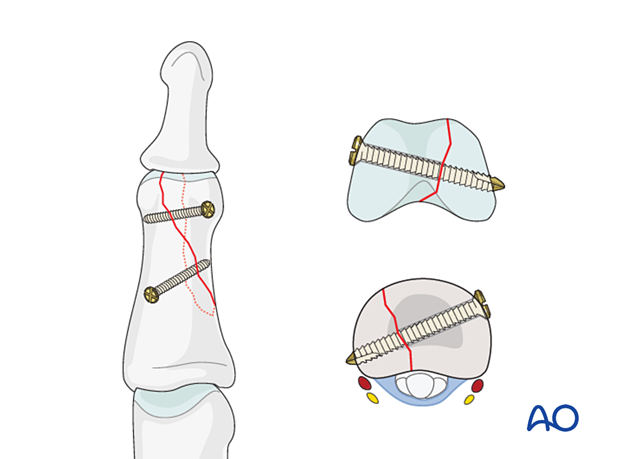
Percutaneous vs open reduction and fixation
Percutaneous reduction and fixation may be performed with acute oblique fractures.
The advantage of a percutaneous reduction and fixation is:
- Shorter operation time
- Less soft-tissue damage
- Faster mobilization
This treatment option needs some skills and experience and special reduction forceps to avoid impingement of swollen soft tissue (atraumatic technique).
If a percutaneous reduction is not achievable, the treatment can be changed to an open surgery.
Open reduction and fixation may be used in acute and delayed cases.
Anatomical reduction mandatory
Although the distal interphalangeal (DIP) joint is somewhat forgiving, articular fractures should be reduced anatomically. Otherwise, the articular cartilage may be damaged, leading to painful degenerative joint disease and digital deformity.
At the DIP joint, this can well be dealt with by arthrodesis, which is a procedure with very predictable outcome, without any major perturbances of the finger.
This illustration shows how even slight unicondylar depression may lead to angulation of the finger.

Outcome
Outcome of middle phalangeal fractures is usually more favorable than in the proximal phalanx. This is largely due to the fact that limitation of DIP joint motion is not such a disability as similar stiffness of the PIP and MCP joints.
2. Patient preparation
Place the patient supine with the arm on a radiolucent hand table.
WALANT is recommended to check stability of fixation and associated tendon lesions with active movement.
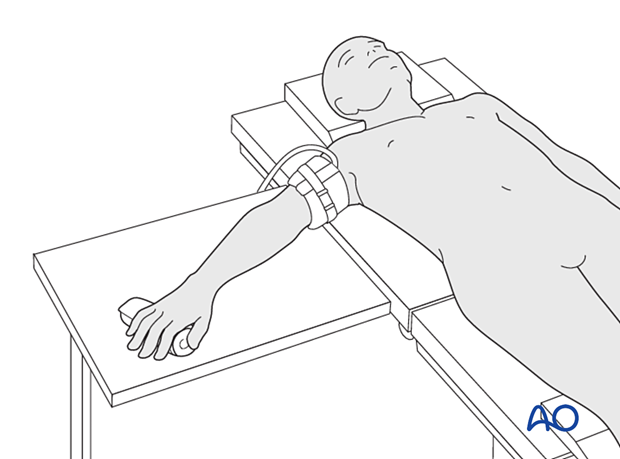
3. Approach
For this procedure a midaxial approach to the middle phalanx is normally used.
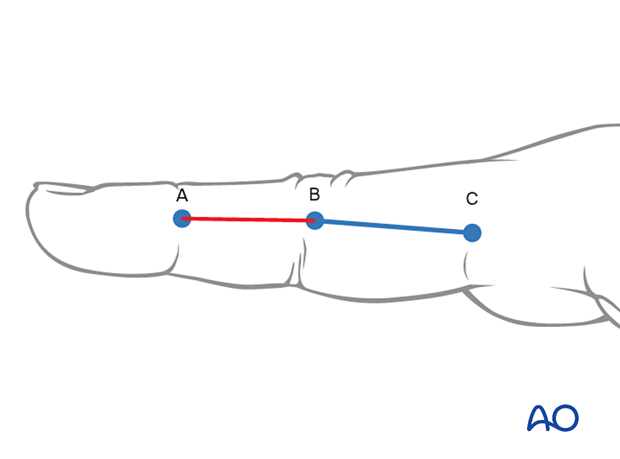
4. Reduction
Indirect reduction
Reduction starts with traction to restore length.
Exert lateral pressure with thumb and index finger or with dedicated percutaneous reduction forceps to reduce the fracture.
Confirm reduction with an image intensifier.
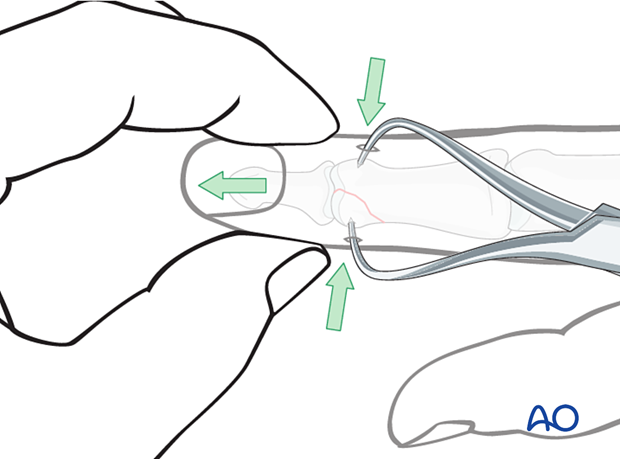
Open reduction
If closed reduction is not successful or in a nonacute case, proceed with an open reduction.
Use a dental pick to gently explore the fracture site to assess its geometry. The pick can also be used carefully to reduce small fragments. Take great care to avoid comminution of any fragment.
It is important to maintain the vascularity of tiny fragments attached to the collateral ligament, to avoid osteonecrosis.
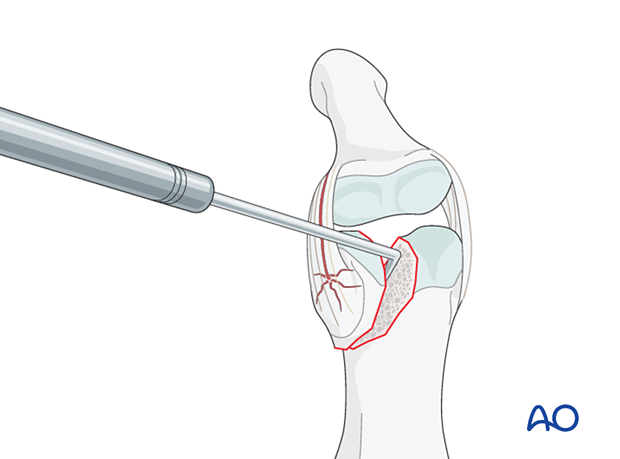
Small pointed reduction forceps can be used for larger fragments gently to rock the fracture from side to side. Be careful not to apply excessive force, which can lead to fragmentation.
Confirm reduction using image intensification.
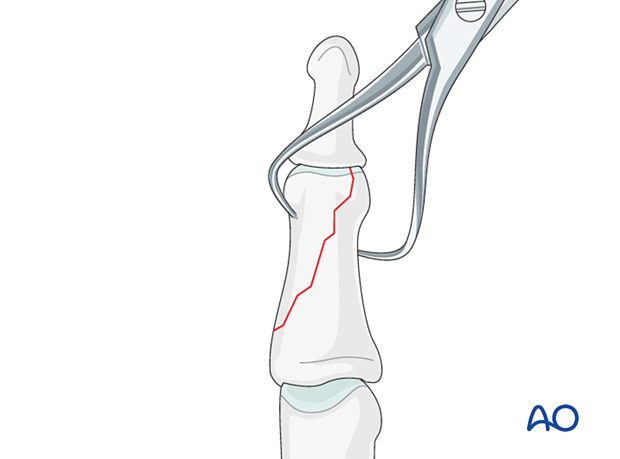
Preliminary fixation
Long oblique fractures can be preliminarily fixed by inserting a K-wire.
Be careful to place it so it will not conflict with later screw placement.
Avoid inserting a K-wire into a small fragment, as it is in danger of fragmentation.

Alternatively, hold the reduction with reduction forceps designed for percutaneous technique. Impingement of soft tissues should be avoided.
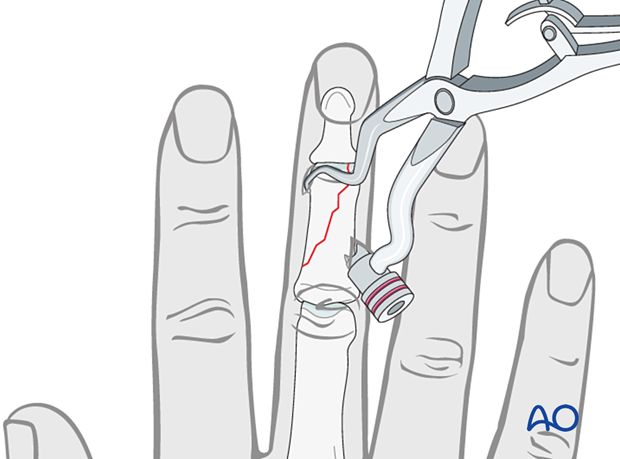
5. Fixation of a small fragment
Screw positioning in a small fragment
If only one screw can be inserted into a small fragment, it will have to be placed within the joint cavity but through the nonarticular face of the condyle, distal to the collateral ligament.
The lateral aspect of the phalangeal head, which is safe for screw placement, can be approached by flexing the distal interphalangeal (DIP) joint.
A headless cannulated screw is recommended to avoid ligament irritation due to a protruding screw head and eventual joint stiffness.
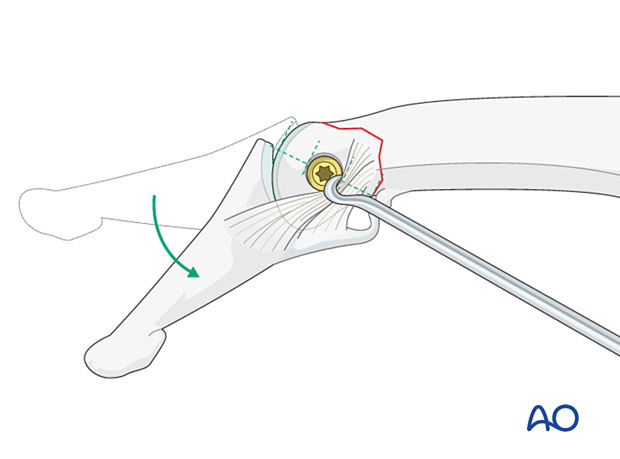
Determining screw size
The screw length needs to be adequate for the screw just to penetrate the opposite cortex.
Keep in mind that at the apex of the fragment, the minimal distance between the screw head and the fracture line must be at least equal to the diameter of the screw head. If necessary, a screw of a smaller diameter will have to be chosen.
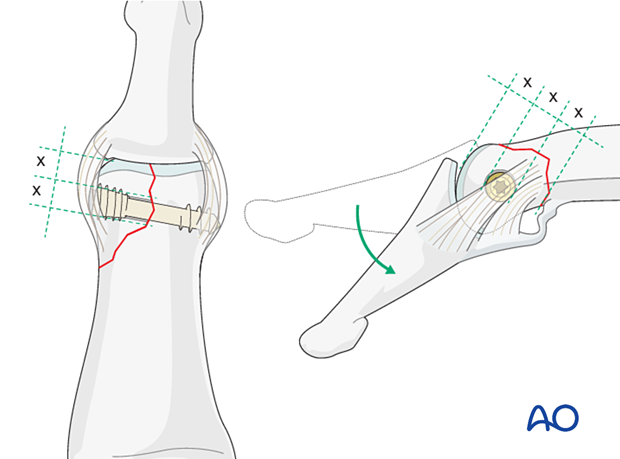
Preparation for drilling
Approach the outer surface of the phalangeal head by flexing the DIP joint and retract the collateral ligament in a palmar direction.
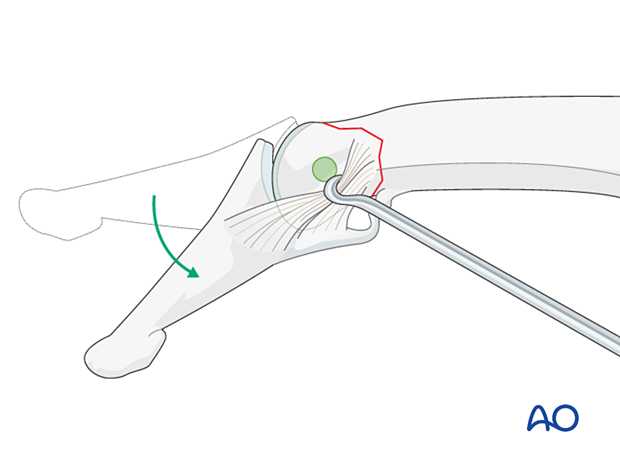
Lag-screw insertion
Insert the headless screw and gently tighten it to compress the fracture.
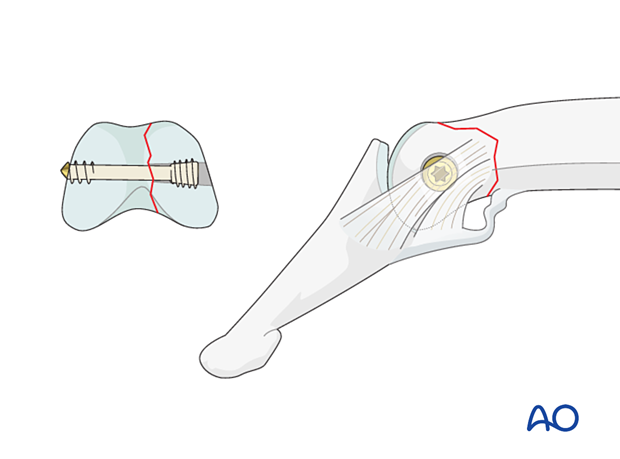
Screw length pitfalls
- Too short screws do not have enough threads to engage the cortex properly. This problem increases when self-tapping screws are used due to the geometry of their tip.
- Too long screws endanger the soft tissues, especially tendons, ligaments and neurovascular structures. With self-tapping screws, the cutting flutes are especially dangerous, and great care has to be taken that the flutes do not protrude beyond the cortical surface.
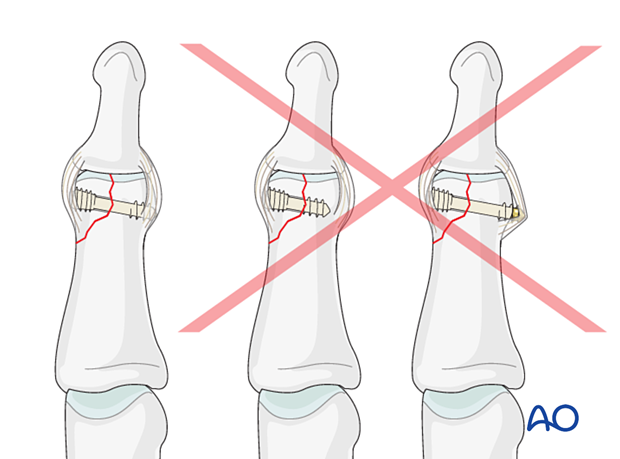
Pitfall: protruding screw head

6. Fixation of a large fragment
Screw positioning in large fragments
In large fragments, all screws can be placed safely proximal to the collateral ligament.
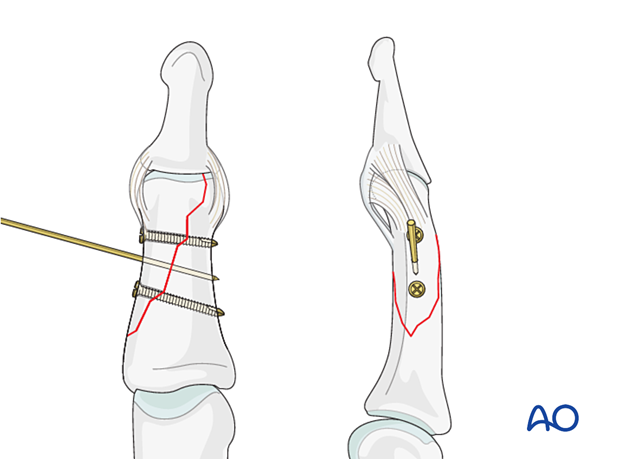
Screw size selection
The exact size of the diameter of the screws used will be determined by the fragment size and the fracture configuration.
The various gliding and thread hole drill sizes for different screws are illustrated here.
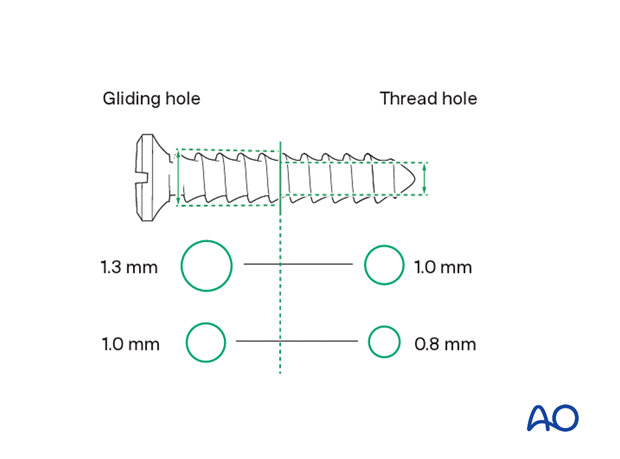
Pitfall: countersinking in the metaphysis
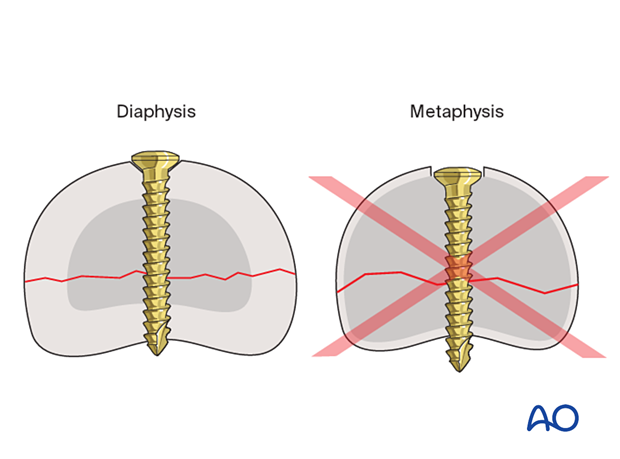
Screw length pitfalls
- Too short screws do not have enough threads to engage the cortex properly. This problem increases when self-tapping screws are used due to the geometry of their tip.
- Too long screws endanger the soft tissues, especially tendons and neurovascular structures. With self-tapping screws, the cutting flutes are especially dangerous, and great care has to be taken that the flutes do not protrude beyond the cortical surface.

Screw insertion
Insert both screws before fully tightening them. Insert the distal screw first. The screw should just penetrate the opposite cortex.
Insert them as perpendicular as possible to the fracture plane. In spiral fractures, the result is that the screws follow a helical disposition.
Alternate tightening of the two lag screws helps avoid tilting the fragment and applies even compression forces over the whole fracture surface.
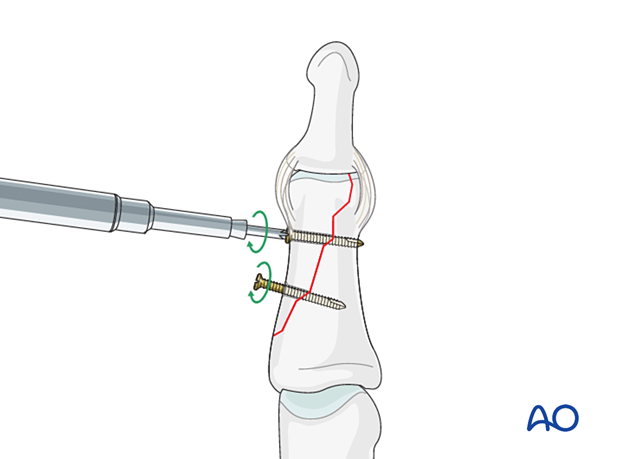
7. Final assessment
Confirm anatomical reduction and fixation with an image intensifier.
Check stability of the fixation by passive flexion and extension of the DIP joint, and by applying gentle lateral and rotational motion. This will help to determine stability to establish strategies for rehabilitation.
In rare cases, these fractures may be associated with tendon injuries. Assessment should exclude such complications.
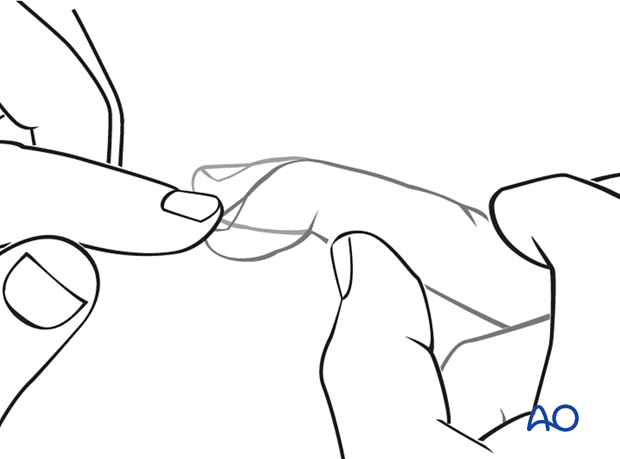
8. Aftercare
Postoperative phases
The aftercare can be divided into four phases of healing:
- Inflammatory phase (week 1–3)
- Early repair phase (week 4–6)
- Late repair and early tissue remodeling phase (week 7–12)
- Remodeling and reintegration phase (week 13 onwards)
Full details on each phase can be found here.
Postoperative treatment
If there is swelling, the hand is supported with a dorsal splint for a week. This should allow for movement of the unaffected fingers and help with pain and edema control. The arm should be actively elevated to help reduce the swelling.
The hand should be immobilized in an intrinsic plus (Edinburgh) position:
- Neutral wrist position or up to 15° extension
- MCP joint in 90° flexion
- PIP joint in extension
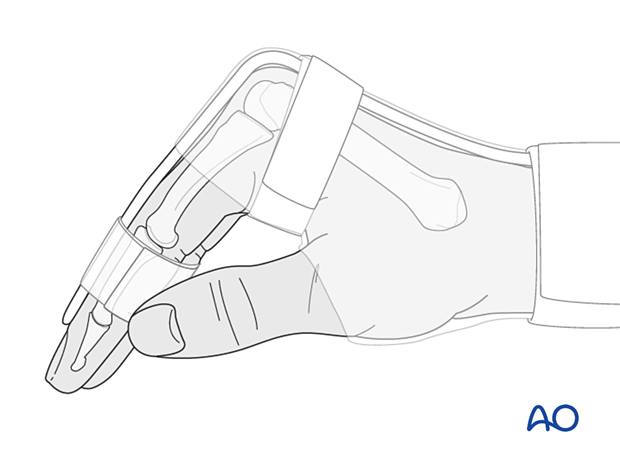
The MCP joint is splinted in flexion to maintain its collateral ligaments at maximal length to avoid contractures.
The PIP joint is splinted in extension to maintain the length of the volar plate.

After swelling has subsided, the finger is protected with buddy strapping to neutralize lateral forces on the finger until full fracture consolidation.
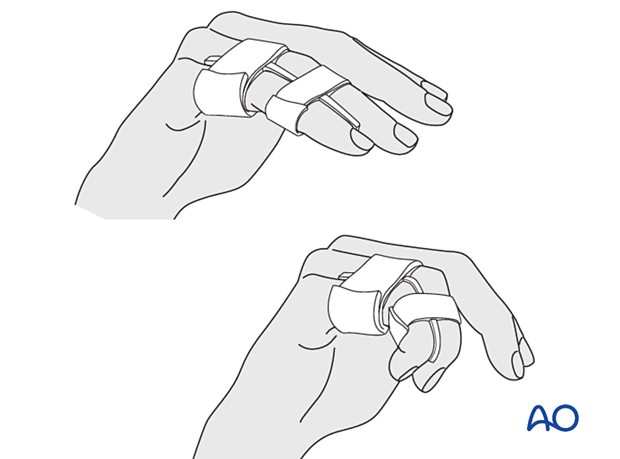
Mobilization
To prevent joint stiffness, the patient should be instructed to begin active motion (flexion and extension) of all nonimmobilized joints immediately after surgery.

Follow-up
The patient is reviewed frequently to ensure progression of hand mobilization.
In the middle phalanx, the fracture line can be visible in the x-ray for up to 6 months. Clinical evaluation (level of pain) is the most important indicator of fracture healing and consolidation.
Implant removal
The implants may need to be removed in cases of soft-tissue irritation.
In case of joint stiffness or tendon adhesion restricting finger movement, arthrolysis or tenolysis may become necessary. In these circumstances, the implants can be removed at the same time.













